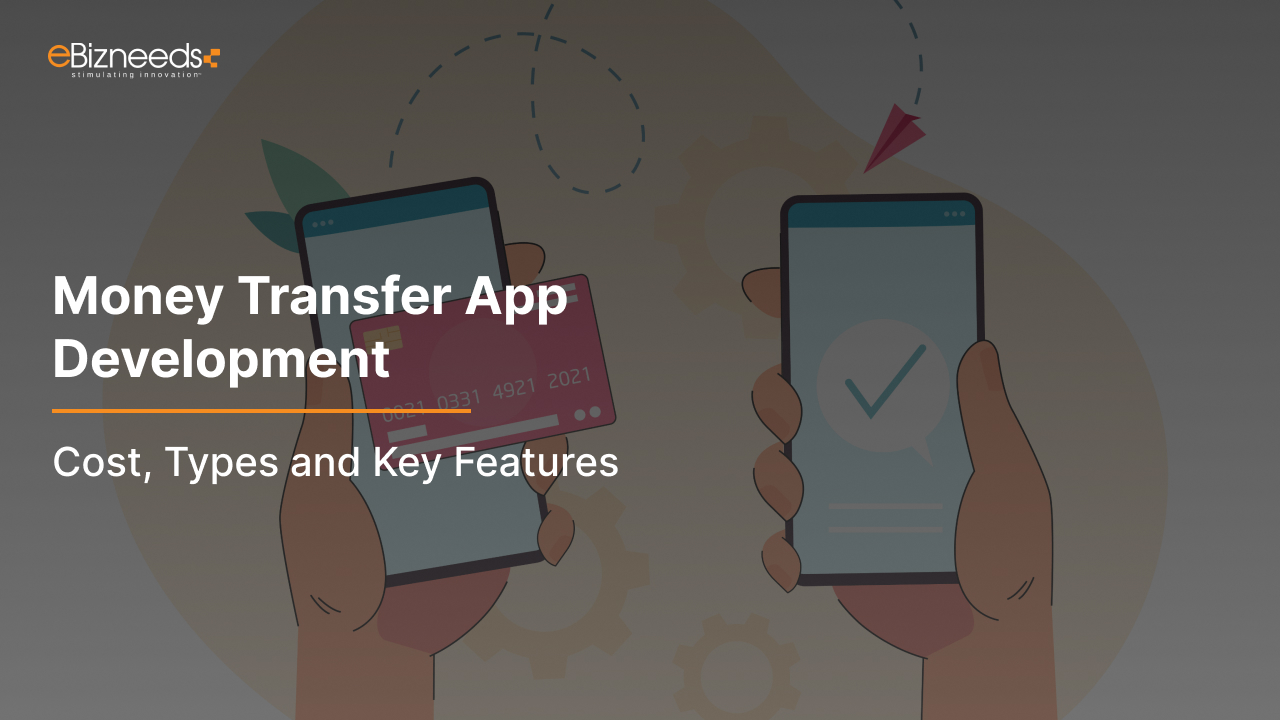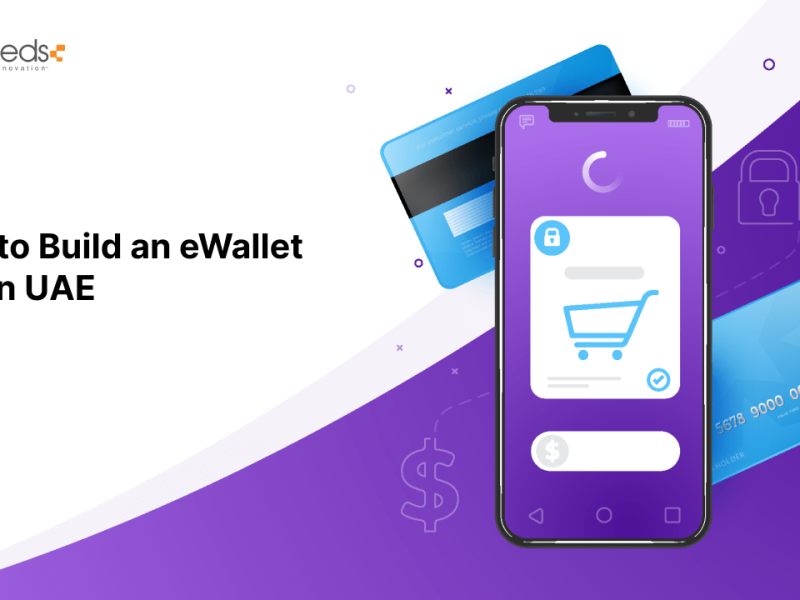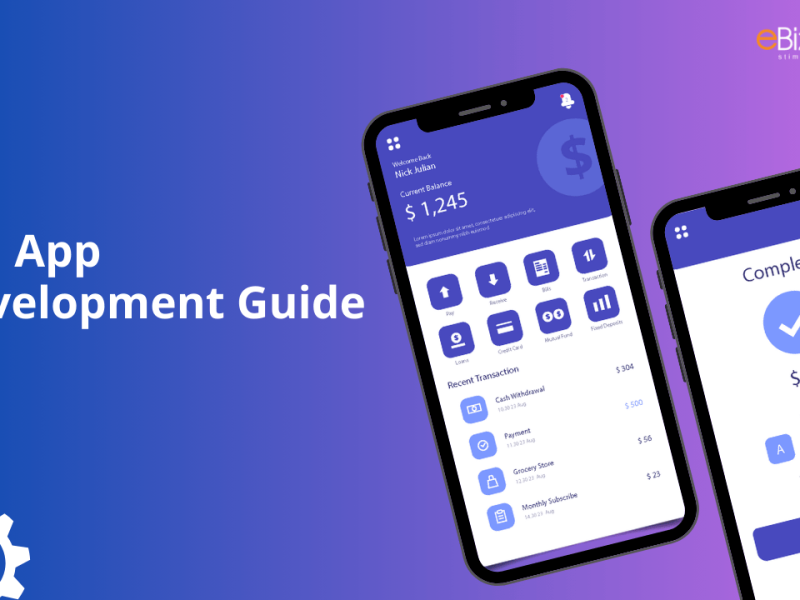The financial world is always changing. Being able to transfer money hassle-free can be only possible with the best Money transfer app development solutions.
Whether you’re sending money to your family or buying international goods or services in exchange for money or managing global business transactions, using the money transfer application is the fast and reliable way.
Nowadays, people can send and receive money anywhere in the world with just a few clicks. Money is now a mobile device and often invisible, our budgets are just numbers on a screen, and we only need apps to access them.
To stay relevant, banks, fintech companies, and other financial organizations must have apps. Payment features are also being added to insurance and cryptocurrency apps.
As the Fintech app development market has reached a majestic height. That means many international companies are investing in it for long-term profits.
If you’re also dreaming of entering the money transfer app development market and thinking about the cost of development then we are here to help you!
In this article, we’ll cover everything you need to know about developing a money transfer app, what features should be included, its benefits, cost, factors that impact the cost and the top money transfer app available globally.
What is a Money Transfer Application?
Are you unfamiliar with the money transfer application? A money transfer application is a type of financial application that’s specially designed for easy and quick transactions between people or organizations on different platforms.
This technology is essential for banks which help them to change traditional banking into user-friendly digital services.
Popular examples of money transfer applications are PayPal, Venmo, and Zelle, which have changed the procedure of sending and receiving money.
The emergence of money transfer apps has made transactions swift and secure. There are also specialized services such as Wise and WorldRemit that focus on international money transfers that offer good exchange rates and lower fees.
These apps are the big evidence that technology is modernizing financial transactions, providing efficiency, security, and customer satisfaction in today’s digital world.
With the use of advanced technologies, money transfer software keeps improving, raising the bar for convenience and reliability in finance.
Key Facts
- Mobile transfer apps let users make secure and easy digital payments.
- These apps are very popular now which makes a great area for ewallet developers.
- To create a money transfer app, you’ll need to plan, design, code, test, launch the app, and gather user feedback.
- Including features like registration, transactions, and transaction history enables your app to look appealing and unique from your competitors. Starting with a basic version (MVP) is a smart approach.
Market Overview of Money Transfer App Development



Mobile payments have become increasingly popular with over 2 billion active users in the year 2022. It’s expected that by the end of the year 2025, the number of users worldwide will reach 4.8 billion.
The global peer-to-peer (P2P) payment market was valued at $1.89 trillion in the year 2021. It is expected that this will grow to about $65.38 billion by the year 2031.
This market is expected to grow at an annual rate of 20.16% from the year 2022 to the year 2030.
The money transfer application has increased quickly. It has seen a tremendous growth of $31.41 billion in the year 2024. The market will reach $36.49 billion by the end of the year 2024.
This is growing at the compound annual growth rate of 16.2. By viewing this incredible growth, we think that it’s a great time to invest in this market.
China is the leader in mobile payment use. By the end of the year 2021, 903.6 million people were using mobile payments. Chinese consumers use P2P transfers because online options are quicker and easier to access.
The rise in online money transfers isn’t just about convenience. In many areas, there are large numbers of people without bank accounts who don’t have access to traditional financial services. The World Economic Forum notes that global financial inclusion still needs improvement.
People who don’t have traditional bank accounts need other ways to make online payments. This creates a large demand for money transfer app development that’s why more entrepreneurs are interested in knowing how to create a successful money transfer application.
Read Also: Overview of eWallet App Statistics 2024, In Depth: Market Insight
As a result, building a money transfer app is a profitable opportunity for both mobile app developers and businesses.
How Does the Money Transfer App Work?
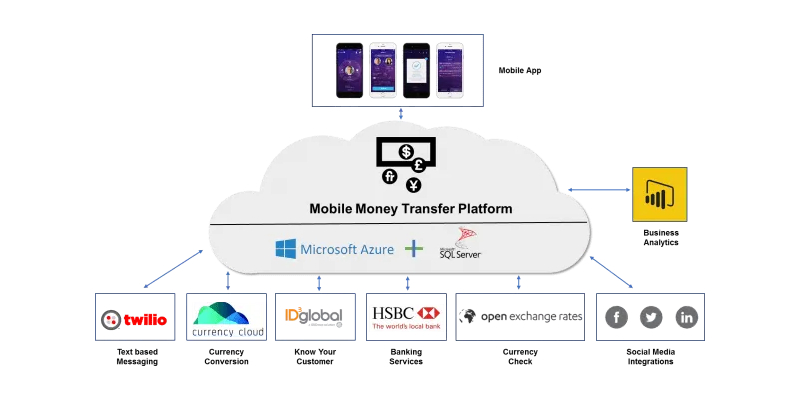


Mobile transfer apps are also known as mobile payment apps. It provides an easy and secure way to make payments without needing cash or physical cards worldwide.
Users just need to download and install a payment app on their mobile device and create an account using their mobile number. After that, they verify the user’s identity which could involve setting up a PIN or using a fingerprint. Having an online business bank account linked to the app can streamline this process even further.
Once that’s done, they can send and receive money. To make a payment, they simply enter the recipient’s information and the payment amount then complete the transaction and get a confirmation.
The process might vary a bit depending on the app and the payment purpose. Just read the points below to understand how to use money transfer apps!
- Download the Application
- Create Your Account
- Verify Your Identity
- Enter Recipient’s Information
- Make a Transfer
- Wait For Confirmation
What Are the Different Types of Money Transfer Applications?
Here we’ll discuss the different types of money transfer applications which are specially used for peer-to-peer payments (P2P).
Independent Services
Money transfer app development solution enables the design of an app that enables users to transfer money from their bank account or credit card to someone else using just their mobile phone or email address.
There are many popular examples like Google Pay, Apple Pay and PayPal. These apps allow you to create a digital wallet to keep your money and make person-to-person payments safe.
Built-in Services
Since transferring money is a key part of our everyday life. There are many apps available that include a money transfer feature. For instance, if you are planning for ewallet app development then it lets users move money between accounts at the same time bank or different bank. Nowadays, messaging apps also provide transfer payment options to their users to send money instantly while chatting. WhatsApp is a good example of this!
There are even more advanced methods like making payments through smart speakers. Typically, users need to connect a bank account or card before they can start a transfer.
If you’re interested in learning more about developing powerful P2P payment apps read our blog till the end!
Step-By-Step Guide to Build Money Transfer Application
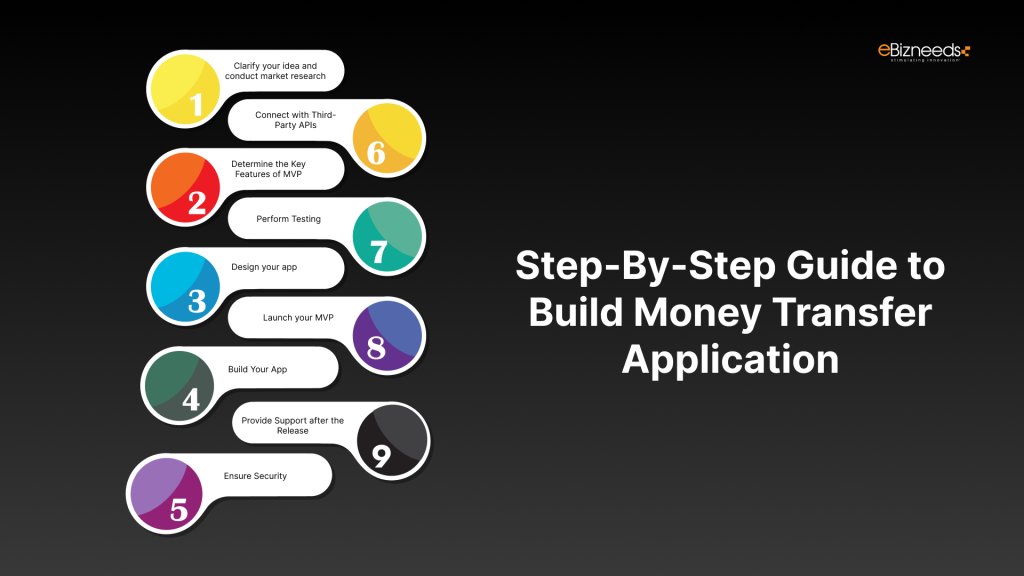


Many businesses want to sign in to money transfer application development. We recommend beginning with an MVP i.e. Minimum Viable Product! There is a simple version of the app that includes only the essential features.
It’s a smart option for entrepreneurs looking to test their ideas in the market without spending too much money.
Our developer’s team has experience in building effective MVPs that include a crypto wallet that lets users buy, store, and transfer various cryptocurrencies.
Clarify Your Idea and Conduct Market Research
The first step in creating a successful money transfer app is to come up with an idea and set clear goals or objectives.
If you want to understand your target audience then conduct market research so that you will understand what are your customer’s needs. Don’t forget to research your competitors to make your app stand out from them.
Determine the Key Features of MVP
After a clear understanding of your app’s purpose, select the key features. Choosing unique and attractive features is the key to making your money transfer application successful.
You can choose a reliable Money Transfer App Development Company and ask them to add features like account management, basic money transfer and translation tracking.
Design your app
The next step is to design the money transfer app. The design influences the user’s interest and experience. It’s important to work with skilled UX/UI designers to create an appealing, attractive and easy-to-use interface for maximum user engagement.
Designers will start by creating a mind map and wireframes to ensure the design fits your requirements, then develop a clickable prototype for you to experience the app live.
Build Your App
At this stage, we start the actual software development. The development procedures involve two key parts i.e. backend and the frontend. The backend developers handle the data, process banking transactions and ensure security.
They make everything run smoothly in the background. Meanwhile, front-end developers work on the appearance and experience of the app which means turning the design into a user-friendly money transfer app with easy-to-use buttons and screens.
At this point, you’ll also see the capabilities or limitations of the tech stack you selected. It’s not just about improving quality but also finding ways to lower costs. For instance, we often use the React Native framework to build custom mobile apps.
This technology allows our team to develop apps for both iOS and Android at the same time. As a result, our client saves time and money while focusing on their business needs.
After exploring several options, we decided on the JavaScript framework. This choice has inspired us to complete more than 500 projects successfully.
Ensure Security
When managing money in an app, high security is essential. To protect the data, use encryption for secure communication between the app and the server.
Adding multi-factor authentication and managing users carefully. Restrict access based on roles and permissions to avoid unauthorized use of sensitive features.
Follow financial rules like Anti-Money Laundering (AML) and Know Your Customer (KYC) guidelines. The rule is simple, regularly review your app for security risks. Having a clear plan for dealing with security breaches will help ensure users’ money stay safe and secure.
Connect with Third-Party APIs
External services offer more features. For instance, users can not only send money but also exchange currency and pay bills safely.
APIs serve as connectors between the append these services that give a smooth way of exchanging data and instructions. Here are some APIs your app may need to meet customer expectations.
- This app allows users to pay their bills, buy services, or make in-app purchases.
- These apps verify users’ identity by checking their ID documents which improves the app’s security and compliance.
- They offer up-to-date exchange rates and enable currency conversion within an app.
- These APIs support cross-border payments by connecting with global financial networks and foreign exchange services.
- Integrating card payment APIs lets users connect their bank cards to make transfers and purchases.
These are the key steps for fintech app development. In a competitive market, adding unique APIs can give a money transfer app an edge. It also lays a strong foundation for the future.
As the app’s popularity and user base grow, APIs help it scale efficiently, managing higher transaction volumes without compromising.
Perform Testing
It’s time to thoroughly test the app to ensure it runs smoothly without any bugs. Make sure it’s compatible with different devices and operating systems.
This is especially important for money transfer app development as users prioritize security or even minor issues, glitches and bugs may affect the company’s reputation.
Launch your MVP
Once the app is thoroughly tested, now it’s time to release it to the market. This includes publishing the app on different platforms like the App Store or Google Play Store and promoting it thoroughly on social media and other marketing channels.
Provide Support after the Release
Launching the app is not the last step in creating a money transfer application. You are required to work on the problems that come up after the app is released, fix any bugs, and add new features if necessary. It’s important to focus on user feedback and keep updating and improving the app.
Major Benefits of Using Money Transfer App
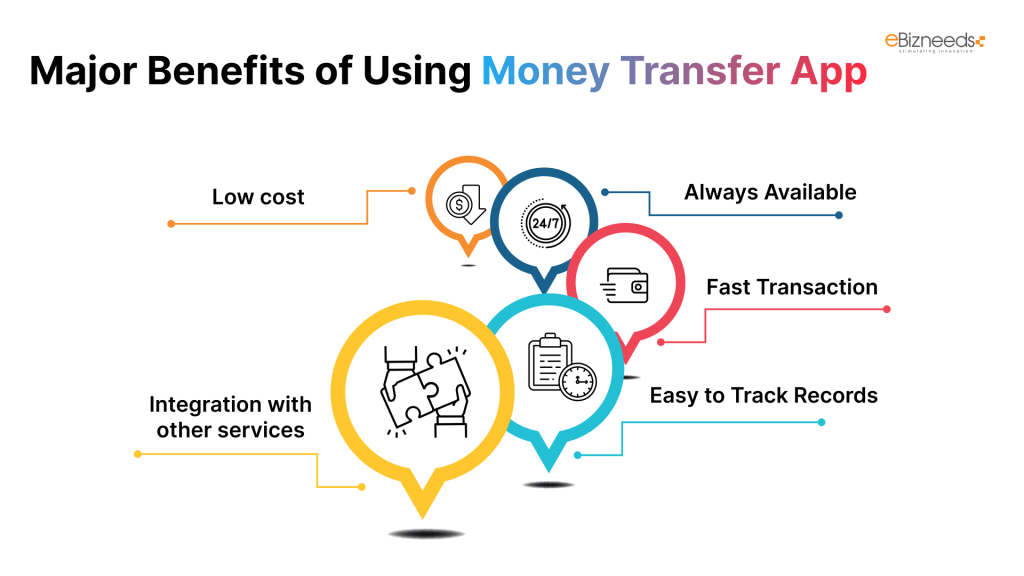


The benefits of using a money transfer app are so impressive. But what makes consumers appreciate these apps? There are many reasons, so let’s explore them:-
Low Cost
Money transfer apps usually have lower costs or more favorable exchange rates than traditional services. Some apps even offer fee-free transfers for certain transactions or in specific areas.
Always Available
Many money transfer apps are available all the time which lets you send or receive money any day, even on weekends or holidays.
Whether you need to help a family member in an emergency or pay an urgent bill, these apps make it easy to access your money when you need it.
Fast Transaction
Money transfer app lets you send and receive money fast and easily, usually with just a few taps on your phone. This means you don’t have to go to a bank or ATM which saves both time and effort.
Easy to Track Records
Money transfer apps keep a record of your transactions which makes it simple to track your spending and finances. It’s an easy way to stay organized, monitor your financial well-being, and stay on top of your financial goals.
Integration with other services
Some money transfer apps connect with other financial services like paying bills, adding mobile credit, shopping online, and using various payment methods.
Key Features to Add to Money Transfer Application
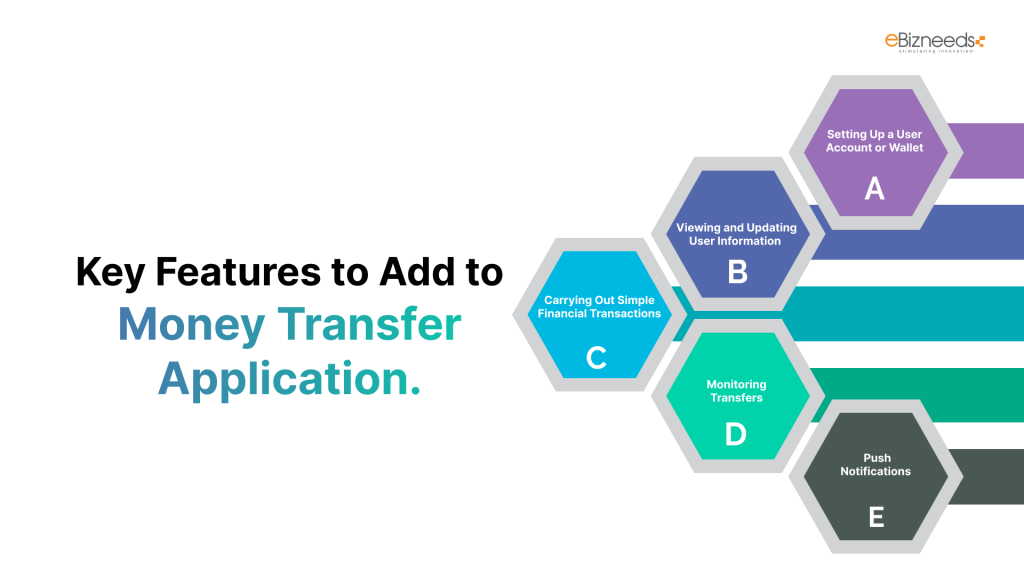


Features that can be included in the money transfer application are of two main categories: mandatory and optional. The development cost and time vary based on how many functions there are and complexity.
Custom apps that involve complicated internal processes like blockchain solutions tend to be more expensive. Let’s have a look over these key features that should be considered:-
Setting Up a User Account or Wallet
Once users download the app, the first thing they need to do is link their credit or debit card, or they can set up an account with an e-wallet to keep their money safe.
Viewing and Updating User Information
Users should have the ability to view and update their personal and financial information including their name, address, contact details, and any linked cards or bank accounts.
Carrying Out Simple Financial Transactions
This feature should be included in the money transfer app which lets users send and receive money as well as set up regular transfers and automatic payments.
If users can pay bills and shop directly through the app, they will be more inclined to use it regularly in their daily routines.
Monitoring Transfers
Transaction history is essential as it helps users keep track of the status, date, time, recipient, and type of transfers.
Push Notifications
Use notifications to keep users updated on important information about their accounts and security. This includes updates on transactions, security alerts, promotions, reminders, and special offers. You can send these notifications through push notifications, SMS, or emails.



Advanced Features for Money Transfer App Development
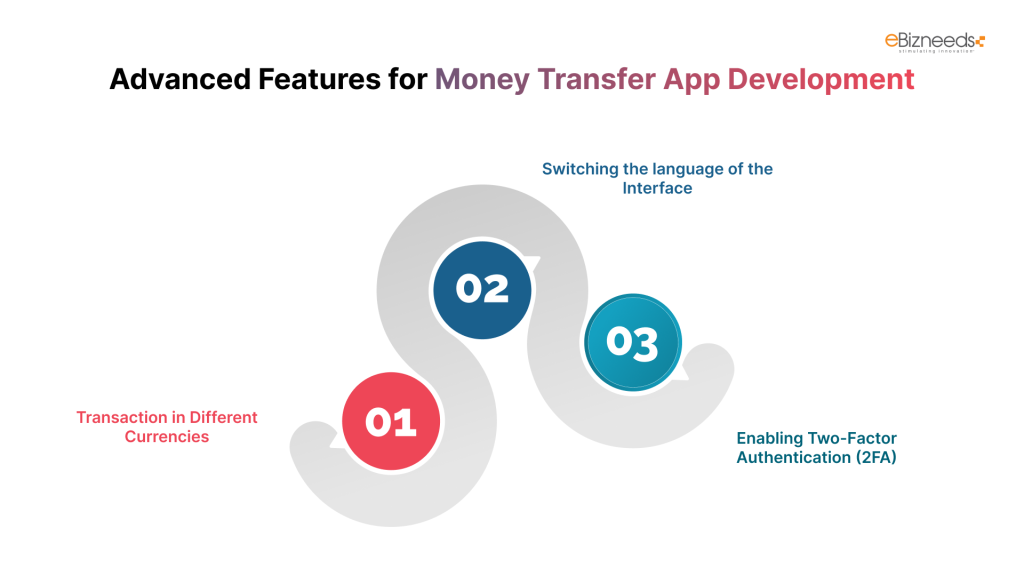


In addition to the basic features, you can include extra options that enhance your money transfer app and make it more enjoyable for users. Here are a few of the important features.
Transaction in Different Currencies
The most popular money transfer apps allow users to handle multiple currencies and cryptocurrencies. These apps also offer real-time exchange rates. This makes it easier for users to send and receive money internationally.
Switching the language of the Interface
Many apps provide a multilingual interface to help users who speak various languages. While this isn’t unique to fintech, it’s important to consider for a better user experience.
Enabling Two-Factor Authentication (2FA)
You can enhance security by requiring users to enter a code sent to their phone or email before completing transactions. Make sure to use advanced security measures and data encryption to keep information safe or secure.
Trends in Developing Money Transfer Apps
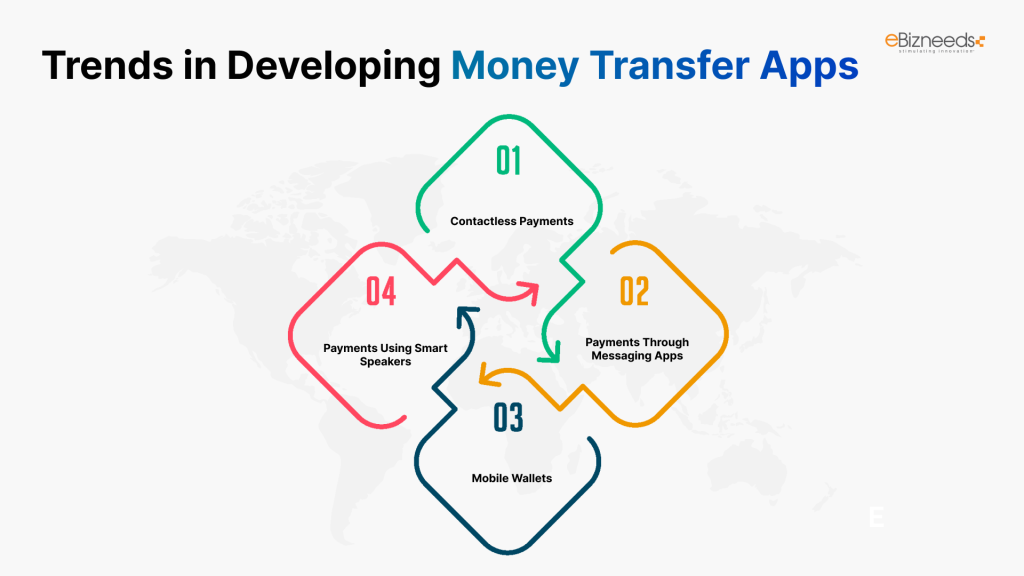


If you’re considering creating your own money transfer app, it’s important to understand the key trends in the fintech industry. This knowledge will help you come up with ideas for the app’s features to share with your development team.
Contactless Payments
Contactless payments have become so important since the pandemic. Everyone prefers to pay through e-wallet apps as these platforms are an important part of our daily lives. Near-field communication (NFC) makes the payment process faster.
You just need to hold your phone near the terminal, and it’s all set. This method also helps keep your PIN safe since no one can see it while you pay.
Payments Through Messaging Apps
It’s much easier to send or receive money to our friends and family while chatting. Right now we have to switch between different apps to share expenses or grant it for group gifts.
However, messaging apps are starting to integrate money transfer features. For instance, people in China use WeChat for banking and Facebook Pay is available in some countries outside the US.
Mobile Wallets
Digital wallets make it easy to pay quickly and securely with just a button press. They also help you manage your money better by providing transaction history, showing statistics and categorizing expenses.
Payments Using Smart Speakers
You can still use smart speakers to manage your finances. There’s no need to grab your phone or laptop, just ask your smart speaker to transfer money, pay bills or check your bank balance.
Legal Requirements in Fintech
Following accepted standards is essential for every financial application. The flow of financial data is heavily regulated, so it’s crucial to grasp the details of the banking industry.
- Know Your Customer (KYC) verification
- General Data Protection Regulation (GDPR)
- Payment Card Industry Data Security Standard (PCI DSS)
- Anti-Money Laundering Policy (AML)
Money Transfer Application Security Features
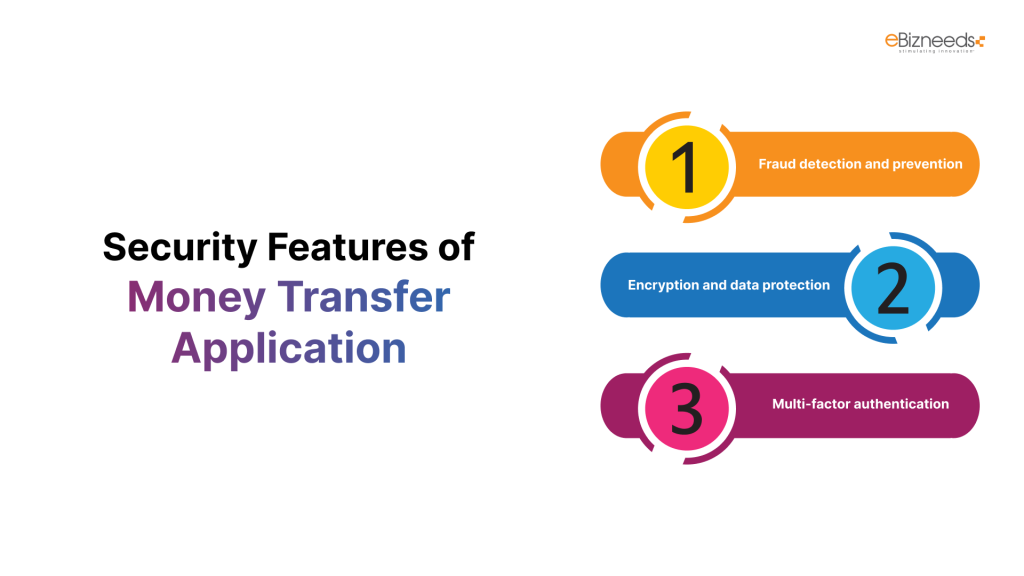


Fraud detection and prevention
Money transfer platforms need strong fraud detection and prevention tools. Algorithms can look at user behavior and transaction history.
If any suspicious activity is found such as unusual login locations, large transaction amounts, or several quick transactions, the account will be suspended until the user confirms their identity.
Encryption and data protection
When you send money, your data is turned into a code that can’t be read on your device and then sent through secure channels. At the other end, it is decoded using the right key.
A hacker who intercepts the data during transmission will not be able to comprehend it. It is crucial to maintain the security of your data by regularly updating the system and utilizing robust encryption techniques.
Multi-factor authentication
Multi-factor authentication (MFA) asks users for extra information to access their accounts. The more ways to verify identity, the more safe it is. This could be a security code sent to your email or another device.
With new technology, we can now use biometrics like fingerprint or facial recognition which are among the safest methods available. MFA reduces the chances of unauthorized access which makes it nearly impossible for hackers to get into a user’s account, even if they have the password.
Top 5 Money Transfer Applications
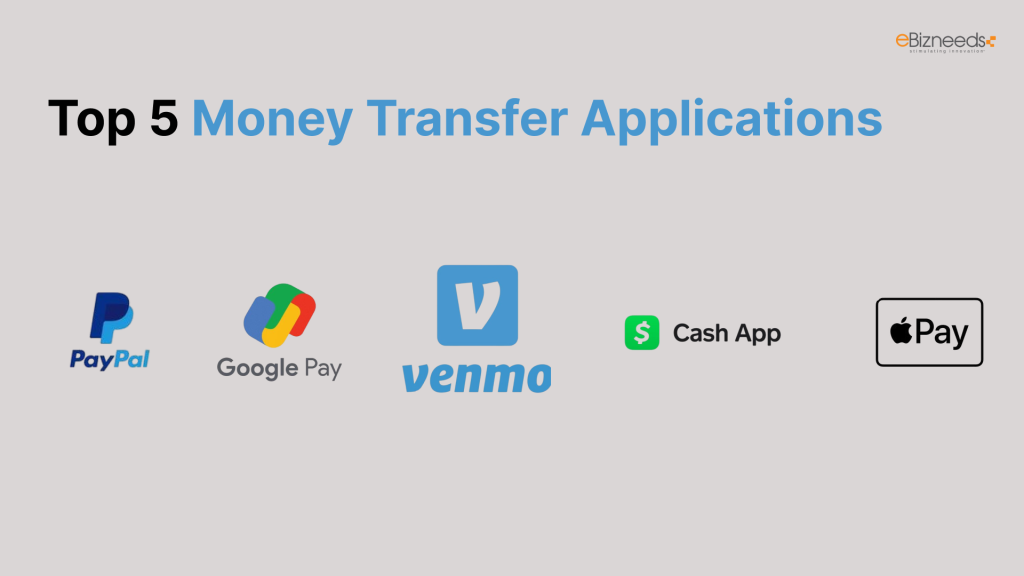


Here we are going to explore a list of the best money transfer apps for the year 2024. We will explore the key benefits and costs of each app that makes it possible for you to choose the right technology for your needs.
PayPal
With a strong set of features, PayPal can handle everything whether you want to send money to a friend in Barcelona, or buy a new cast iron, or need to donate money to your favorite charity, PayPal is there to help you. To transfer money, simply connect your bank account and select the person you want to send it to, they will receive it within minutes.
However, like many other money transfer apps, it may take at least a day for the funds to clear from your checking account. PayPay is just beyond the money transfer service. It’s a digital wallet. You can store money in it or link your bank account, credit card or debit card to make direct payments.
- PayPay is best for anything related to money.
- You just need a bank account or credit card.
- They ask for an Email address and phone number.
- The app is free for consumers, merchants pay 1.9-3.5% per transaction.
- Instant transfers usually happen in a few moments but can take up to 30 minutes.
Venmo
Want to create an app like Venmo? Our experienced team provides feature-rich solutions for money transfer app development. The best thing about Venmo is it’s simple to use. Just sign up, link your bank account and you’re all set to send and receive money.
Whether you’re splitting a bill with friends or sending money to anyone or paying the neighbour, Venmo makes it super easy to send money. When you sign up, you can choose your privacy setting which allows you to share your payments with friends or even publicly. You can also keep transactions private through Venmo. Though it is popular for its social payment feed.
- Venmo is best for transferring money to your friends and family.
- Users should have their bank account or credit card.
- The app asks for your valid email address and phone number.
- Regular transfers are free but instant transfers cost 1.75% (minimum $0.25, maximum $25).
- Instant transfers happen right away, while regular transfers take 24-72 hours, depending on your bank.
Cash App
Cash App is known and popular among Gen-Z as the app offers a lot of features. It makes sending money to friends and family super easy with no additional fees for debit cards or bank account transfers.
Cash App combines banking, brokerage, money transfers and coupon deals into one app. If you need to send money to anyone in the US or UK they likely have a Cash App. All you need is their cash, phone number or QR code.
- Cash App is best for Instant money transfers and online shopping.
- You only need a bank account or credit card.
- They will need a phone number and email address.
- Instant transfers charge 0.5%-1.75% (minimum $0.25), credit card payments have a 3% fee and 2.5% on crypto transactions.
- Instant transfers are immediate while regular transfers take 1-3 business days, it depends on your bank.
Google Pay
Google Pay launched in 2011, offering users a great platform to transfer and receive money, cover transaction costs and track their expenses. The app lets you transfer money between the US and India but you can use it for online shopping payments in many other countries as well.
Similar to other apps we’re discussing, Google Pay includes a virtual wallet feature that allows you to link bank accounts, debit cards and credit cards.
If you are starting with a money transfer app development, then we can help you create a great app like Google Pay.
- Google Pay is great for sending money and online shopping.
- You need a Google account and a bank account.
- Also required bank details and phone number.
- Cost: 1.5% or $0.31 (whichever is more) to transfer money to a debit card.
- Transfers to debit cards usually take minutes (up to 24 hours); bank transfers take 3-5 business days.
Apple Pay
Apple Pay makes it easy for Mac users or other Apple users to transfer money using a phone, PC, or a watch to another who uses an Apple device.
If you also have an Apple device Connect your bank account then use iMessage to send money and approve the payment using your device’s security features like Touch ID or Face ID.
- Apple Pay is useful for sending money to other Apple users and online shopping.
- You need an iPhone, MacBook, iMac, or other Apple devices, and a bank account.
- They require your Apple ID and banking details.
- Regular transfers are free, while instant transfers cost 1.5% (with a minimum fee of $0.25 and a maximum of $15).
- Instant transfers usually go through immediately (up to 30 minutes), while regular transfers can take 1-3 business days.
How Much Does it Cost to Create a Money Transfer App?
Want to have your own money transfer app? This paragraph will help you to look out for the essential factors that influence money transfer app development costs.
Based on similar projects we’ve completed, the estimated cost for developing a money transfer app ranges from $85,000 to $98,000. This includes the entire development process, covering UI/UX design, creating both iOS and Android versions, and conducting QA testing.
App’s Features and Complexity
Usually, the more features you want in your money transfer system, the more it will cost to develop. Each extra feature needs coding, testing, and possibly integration with external services or APIs. That’s why it’s often best to start with essential features.
If you plan to include bill splitting, international transfers or special user interactions, it makes the project more complex which increases costs.
Additionally, if your app has advanced features, you might need to invest in customer support as well.
Platform and Tech Stack
Cross-platform development platforms like React Native cut costs compared to building separate native apps for iOS and Android. The React Native framework lets you reuse code across different platforms.
Choosing popular programming languages with a large developer community also helps lower development expenses.
UX/UI Design
Designing an appealing and user-friendly interface requires to spend more money on development. The design’s complexity such as the number of screens, custom graphics and animations can greatly affect the cost.
Moreover, making sure the app functions smoothly on different devices and screen sizes like smartphones and tablets adds to the development complexity and expenses.
On Going Maintenance and Support
As we discussed earlier, the app’s security is a top priority. Keeping up with security measures required resources. Regulatory requirements may also evolve, necessitating updates to the app’s compliance features.
Each update or improvement needs testing to ensure that new changes don’t generate bugs which adds to the ongoing development costs.



Conclusion
Many individuals use money transfer apps every day, and this trend is expected to continue. With more accessible technologies emerging, the number of users is predicted to steadily grow. Therefore, creating a money transfer app is likely to be a smart and profitable decision. If you’re a start-up with an idea that you want to develop and need technical support, eBizneeds can help you build a money transfer app tailored to your users and designed to generate revenue.
FAQs
Begin the money transfer app development by clearly defining your idea to ensure it meets the needs of your target audience. Next, look for a company that offers complete development services to turn your idea into a working product. Then, allow the experts the necessary time to build an effective app for you.
Before creating your money transfer application, it’s important to think about a few key factors like customer requirements, an overview of the fintech market, and rules & regulations related to this field. It’s wise to select a reliable development agency that has experience in building these types of apps.
Usually, money transfer app development time depends on various factors like complexity, features, development team experience, and so on. If you’re aiming for a more advanced money transfer app, it might take around 5-6 months.
Considering the similar projects we’ve worked on, the estimated cost to build a money transfer app ranges from $85,000 to $98,000. This includes everything from UI/UX design to building versions for Android and iOS as well as quality assurance testing.



Naveen Khanna is the CEO of eBizneeds, a company renowned for its bespoke web and mobile app development. By delivering high-end modern solutions all over the globe, Naveen takes pleasure in sharing his rich experiences and views on emerging technological trends. He has worked in many domains, from education, entertainment, banking, manufacturing, healthcare, and real estate, sharing rich experience in delivering innovative solutions.
